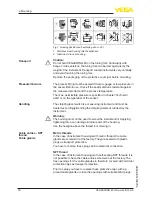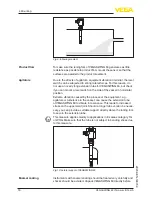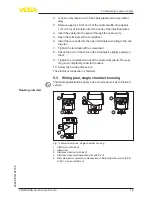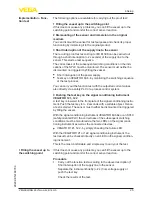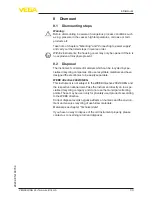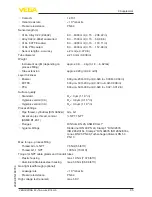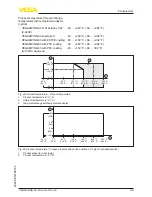
25
6 Setup
VEGASWING 63 • Two-wire 8/16 mA
29232-EN-180704
The following options are available for carrying out the proof test:
1 Filling the vessel up to the switching point
If this does not cause any problems, you can fill the vessel up to the
switching point and monitor the correct sensor reaction.
2 Dismounting of the sensor and immersion in the original
medium
You can dismount the sensor for test purposes and check its proper
functioning by immersing it in the original product.
3 Short interruption of the supply line to the sensor
The recurring proof test according to IEC 61508 can be carried out
through a short interruption (> 2 seconds) of the supply line to the
sensor. This starts a test sequence.
The correctness of the subsequent switching conditions on the indi-
cations of the SPLC must be monitored. The sensor must neither be
dismounted nor triggered by filling the vessel.
•
Short interruption of the power supply
•
Test key on VEGATOR 636 - by monitoring the switching sequence
of the test process
You can carry out the function test with the outputted current values
also directly via a safety PLC or a process control system.
4 Pushing the test key on the signal conditioning instrument
VEGATOR 121, 122
A test key is lowered in the front plate of the signal conditioning instru-
ment. Push the test key for > 2 seconds with a suitable object. Hence
a test is started. The sensor must neither be dismounted nor triggered
by filling the vessel.
With the signal conditioning instrument VEGATOR 636 Ex or an SPLC
(safety-oriented PLC) the correctness of the subsequent switching
conditions must be monitored via the two LEDs on the signal condi-
tioning instrument as well as the connected devices.
•
VEGATOR 121, 122 - by simply checking the failure LED
With the VEGATOR 121 or 122 signal conditioning instrument, the
test result can be checked directly on an LED on the signal condition-
ing instrument.
This is the most comfortable and simple way to carry out the test.
If this does not cause any problems, you can fill the vessel up to the
switching point and monitor the correct sensor reaction.
Procedure
1. Carry out the function test according to the above description (1
Short interruption of the supply line to the sensor.
Separate the instrument briefly (> 2 s) from voltage supply or
push the test key.
Check the results of the test.
Implementation - Func-
tion test
1 Filling the vessel up to
the switching point




